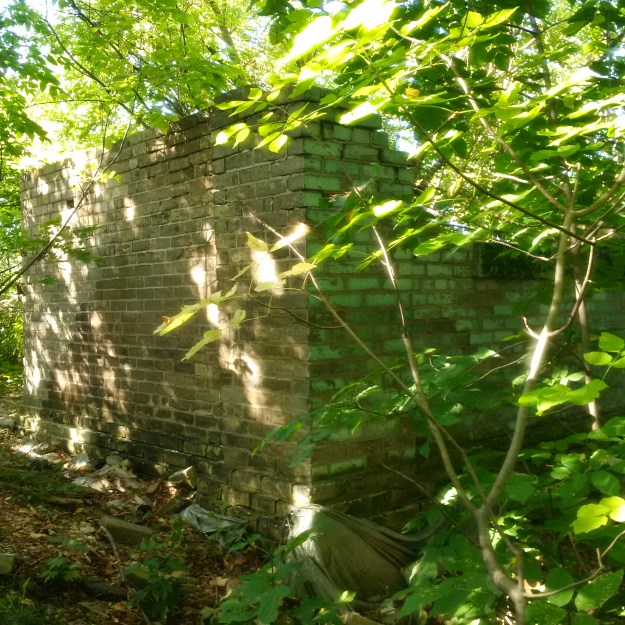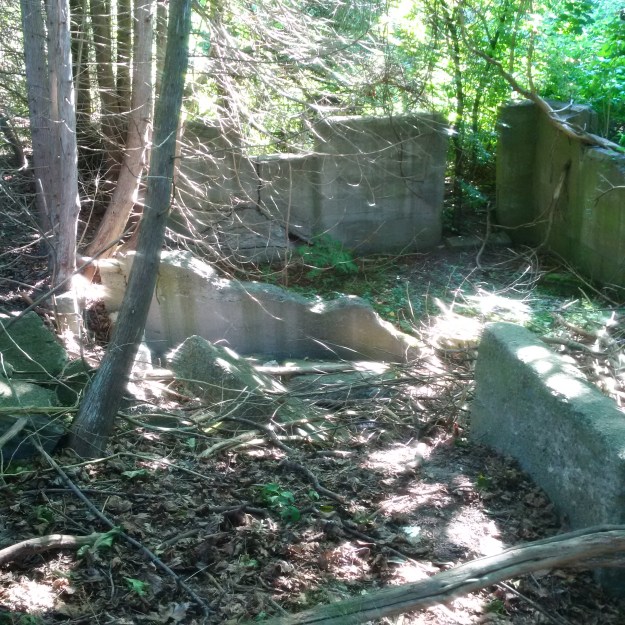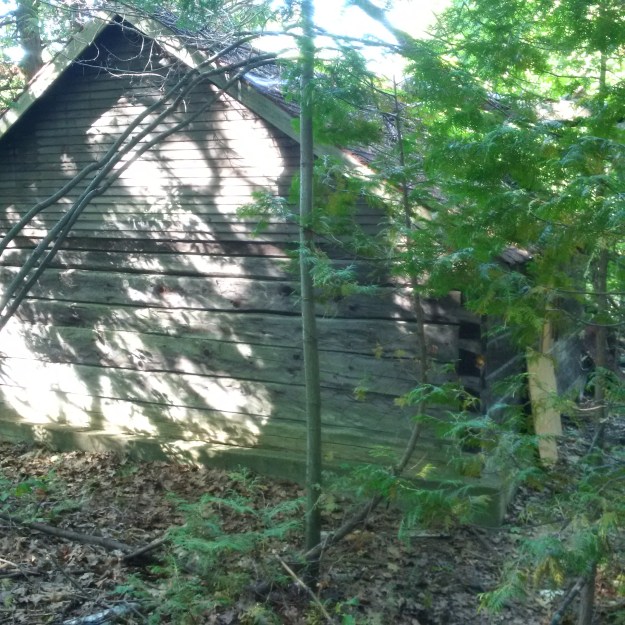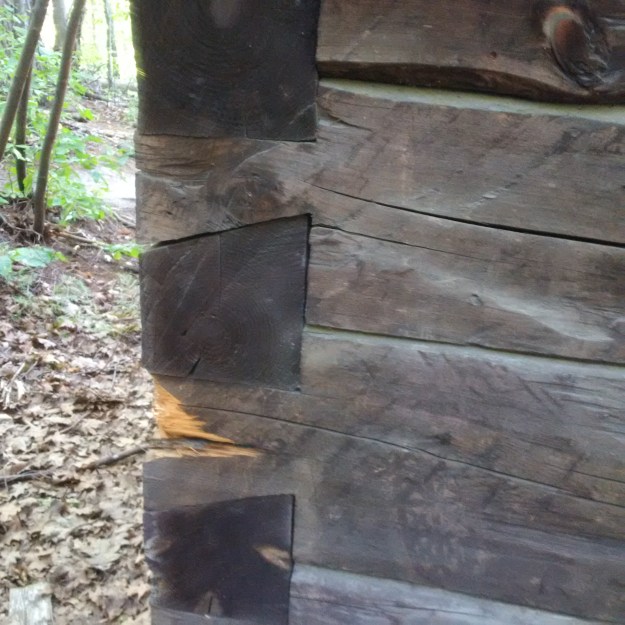Sunday September 4, 2016
Bond Lake is a 55 acre, spring fed lake, just north of Richmond Hill on Yonge Street. Perhaps it’s location has been the key to the various uses the lake and surrounding lands have had over the years. I decided to explore the lake and surrounding trails and so I parked at the end of Trish Drive where a pathway leads to the Oak Ridges Trail. This trail extends the length of the moraine and is listed at 260 kilometers long. The 1877 county atlas below has been marked in brown to show approximately where Old Colony Road and Trish Drive are today. The route of the hike around the lake is shown in red.

Before I had walked very far along the trail I came to a large stand of sumac trees. Experience has shown that these often hide signs of habitation and this was no exception. The foundations for a barn can be found in this bush. This is likely the barn from the Walker Estate seen on the map above although the Whitney & Morton barn should also be in the same area.

From the earliest days Bond Lake was used for recreational purposes and the first settlers in the area used the lake for fishing, swimming and boating in the summer and curling in the winter. The Metropolitan Railway extended north from Richmond Hill in 1899 and built an electric generating station at Bond Lake to supply the line north of there with power. The fact that the lake was already in use for leisure activities led the Metropolitan Street Railway to buy the 200 acre farm around the lake from William Bell. Along with landscaping the grounds they also set about building the railway sidings and platforms for the tourists they hoped to carry to the lake. The picture below from the Toronto Reference Library shows people arriving at stop 35, Bond Lake, on June 20, 1924.

The park proved to be a real money maker for the railway when 60,000 people went through the gates in 1901 alone. The vast majority of these also paid fare on the railway to get there. It was a popular spot for couples to go for romantic dates and more than once an engagement would take place at the pavilion in the park. Church and company groups as well as families flocked to the park for it’s clean water. The railway advertised the health benefits of the lake, claiming that it was cleaner than Lake Ontario because it was 720 feet above the level of the larger lake. No doubt at the start of the 20th century Lake Ontario around Toronto was pretty dirty with raw sewage. Another odd claim in the railway literature is that the lake’s cool breezes meant that guests didn’t need to worry about mosquitoes. The trail continues for about 2 kilometers until it reaches Yonge Street. The fields throughout here have been replanted with rows of young trees. Before too long this area will all be a new forest. Signs of the fall are in the fields and trees where the bright greens of summer are giving way to yellows and reds of fall. Rows of newly planted trees can be seen in the background of the picture below.

After the success of the 1901 season the company invested in a concert pavilion and baseball fields. They kept a boat called The Gypsy to carry passengers around the lake, delivering them to various wharves. Row boats could be rented for those who wanted to casually explore the lake. The remains of the electric power generating station are close to Yonge Street and both the substation and the foundations for the generating building have been presented in two previous posts. The Toronto & York Radial Railway and the Electric Railway Generating Plant describe this site in greater detail and with many pictures. The foundations for the power house remain but the building itself has been removed. The archive photo below shows how the power house looked. Today, just the cut stone blocks of the foundation remain and they are being taken over by the forest.

A car repair barn was constructed near the generating facility but not much remains other than the corner of two walls.

Sticking to the side of the lake the trail becomes little more than a footpath after leaving the formal trail. Along this little pathway, not far from the substation, is an old pump house.

The park was the first “electric park” in Ontario meaning that it was the first one to have electric lighting and later a merry-go-round. The foundations for the gatehouse and station can still be seen along the trail.

Hopefully you won’t be needing the washrooms as they look like they need a serious cleaning.

In 1936 Robert Clifford and Edith Gamble built a cottage on the lake. It has been abandoned and is starting to decay. There was a front porch but it has since collapsed. It is just one of many buildings that were along the lake shore. Bond Lake Inn and Stables are also now long gone. The first pavilion, wading pool and merry go round have also all disappeared. The second pavilion has been moved and is now in use as a three-car garage.

The construction of this log cabin illustrates a skill in dovetailing. This woodworking technique likely predates recorded history as examples have been found in First Dynasty Egyptian tombs (around 3000 B.C.) and in ancient Chinese Emperor’s tombs. A series of trapezoid pins on one part match with tails cut on the mating part. Once set, a dovetail joint has a very high tensile strength, or resistance to being pulled apart, and requires no mechanical fasteners. Pioneers created log homes with dovetail corners that are still standing 200 years later.

Another sure sign of the coming of autumn is the yellow of goldenrod in the meadows. There are about 120 species of this plant and they are often blamed for hay fever. In reality the pollen is very heavy and sticky and isn’t windblown. Ragweed, which blooms at the same time, is the normal problem for most people. The young leaves can be eaten and goldenrod is used in herbal tea. The plant is a prime source of nectar for bees, flies, wasps and butterflies.

There are many other foundations and ruins at Bond Lake but it appears that more time should be spent when there are no leaves on the trees. This is a very interesting place to explore.
Google Maps link: Bond Lake
Like us at http://www.facebook.com/hikingtegta
Follow us at http://www.hikingthegta.com

Pingback: Back Tracks – 5 Years of Trails | Hiking the GTA
Pingback: Schomberg | Hiking the GTA
Pingback: The Stone Cottage at Bond Lake | Hiking the GTA
I lived this!I my Dad was born in Toronto in 1913,so he could have been one of those little kids in the photo going for a swim to beat the heat!I live that old dovetailed building!I’d like to buy it and move it to my cottage lit on Lake Simcoe and restore it!
Pingback: Log Cabins | Hiking the GTA
I guess there aren’t any photos around that show the lake with the merry-go-round and other attractions?
Pingback: Georgina | Hiking the GTA
Pingback: Eversley – Ghost Towns of the GTA | Hiking the GTA
Hello, I was wondering how to access the Bond Lake Generation Station area? I am a Geocacher and looking into adding this to an Adventure Lab.
You can follow the Oak Ridges Trail in from Yonge Street just south of Old Colony Road.
Pingback: Back Tracks – 8 Years of Trails | Hiking the GTA
I found the missing Merry Go Round at Bond Lake.